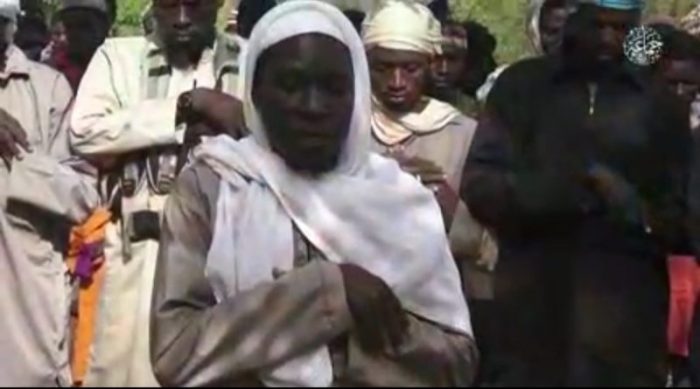24th May, 2019

If one ever wonders how Boko Haram and ISWAP guerrillas pick soft targets and avoid head-on clashes with the gallant Nigerian soldiers, a hitherto secret manual of war by the terrorist group has shed some light.
The manual suggests the terrorists tactics is deliberate: they are fighting according to instructions from Abu Bakr Al Baghdadi, the group’s elusive leader.
Reuters quoting Islamic State al-Naba online newspaper, said Baghdadi has encouraged his followers to adopt guerrilla tactics and published detailed instructions on how to carry out hit-and-run operations.
According to the report, the guidelines make clear the group is adopting it as standard operating procedure, especially as they have lost territories in all their theatres of war, in Iraq and Syria and also in North East Nigeria, where a degraded Boko Haram metamorphosed into ISWAP.
The operating procedure in a nutshell is a style of fighting that avoids direct confrontation and that seeks to weaken the state military by attrition.
“The sad reality is that ISIS is still very dangerous,” said Rita Katz, executive director of the SITE Intelligence Group, which tracks extremists. “It has the tools and foundations needed to build insurgencies across the world.”
In a rare video published by IS’s Al Furqan network in April, the group’s leader Abu Bakr al-Baghdadi encouraged followers to fight on and weaken the enemy by attrition, stressing that waging war is more important than winning.
Hassan Abu Hanieh, a Jordanian expert on Islamists, said IS has used guerrilla tactics to temporarily seize towns in order to attract media coverage but also as part of a new strategic approach.
“This kind of war has turned into a strategy for the group,” he said. “At this stage they are using it as a war of attrition, like Baghdadi said in his latest speech.”
In April, IS claimed it had attacked the town of Fuqaha in Libya, killing the head of the town council and setting fire to the municipal guard headquarters. “They seized control of the town for several hours and then returned to their bases safely,” the claim said of the IS fighters.
In recent weeks, al-Naba newspaper, one of IS’s most important media outlets, has published a four-part series titled “The Temporary Fall of Cities as a Working Method for the Mujahideen”.
In the articles, IS urged fighters to avoid face-to-face clashes with the enemy — something the group had previously encouraged.
The series explained how guerrilla fighters can weaken the enemy without taking losses. It urged the jihadists to seize weapons from victims and grab or burn their valuables.
Among the goals of hit-and-run attacks, the series said, was to take hostages, release prisoners and seize cash from the enemy.
Other goals were to “secure the needs of fighters” by collecting money, food, medicine and weapons “particularly when it is difficult to secure these needs because (the fighters) are in a weak position,” one of the articles said.
These guerrilla warfare manuals are the most detailed IS has published yet, Rita Katz said.
The language is similar to the one used in manuals published years ago by Al Qaeda in Saudi Arabia via its “al-Battar” electronic magazine, which provided military instructions to supporters and cells around the world, she said.
IS’s new manuals show that the group is short on fighters and finances, she added.
When it lost its territory, IS also lost an important source of income, mainly taxes and oil revenue.
“Financially, territorially and militarily speaking, the group is very weak,” said Katz. “That said, ISIS leadership seeks to revive its so-called caliphate, with special attention on areas outside of Iraq and Syria.”
Although not all of the group’s claims can be confirmed, it has announced some wide-ranging operations.
On April 18, IS claimed its first attack in Democratic Republic of Congo and announced the creation of a “Central Africa Province” of the “Caliphate”. Since then the group has claimed several more attacks in Congo.
On May 10, IS claimed it had established a province in India. It also said IS fighters had inflicted casualties on Indian soldiers in Kashmir.
The same day, militants on motorbikes stormed a town in northeastern Nigeria and opened fire on residents and soldiers in an attack later claimed by Islamic State.
IS has claimed more operations in Nigeria and dozens of similar attacks in recent weeks in Afghanistan, Niger, Somalia, Egypt, Pakistan, Chechnya, Sri Lanka and elsewhere. In several cases, the group published pictures of bullets, rifles and other weapons it said it had collected from soldiers.
By striking in a wide range of places, IS is promoting itself and proving it can reorganize and modify its strategy, said Laith Alkhouri, co-founder and senior director at Flashpoint, which monitors militants’ activity online.
“ISIS super-temporarily seizes areas, flexes its muscles, subdues locals, even recruits from amongst them, and taunts governments by exposing security flaws or weaknesses,” he said. “This is a considerably important avenue for ISIS’s growth.”
Guerrilla war is a less costly way to inflict damage and the group is using the tactic where it wants to expand, such as eastern Afghanistan, northeastern Nigeria, Somalia, North Africa, the Indian subcontinent and central Africa, he said.
“The group’s media realizes the importance of highlighting this, not only for boosting the morale of the support base,” Alkhouri said. “But just as importantly for expanding its footprint geographically — effectively setting up and expanding unrest zones around the world.”


